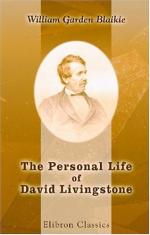CHAPTER IV.
FIRST TWO STATIONS—MABOTSA AND CHONUANE.
A.D. 1843-1847.
Description of Mabotsa—A favorite hymn—General reading—Mabotsa infested with lions—Livingstone’s encounter—The native deacon who saved him—His Sunday-school—Marriage to Mary Moffat—Work at Mabotsa—Proposed institution for training native agents—Letter to his mother—Trouble at Mabotsa—Noble sacrifice of Livingstone—Goes to Sechele and the Bakwains—New station at Chonuane—Interest shown by Sechele—Journeys eastward—The Boers and the Transvaal—Their occupation of the country, and treatment of the natives—Work among the Bakwains—Livingstone’s desire to move on—Theological conflict at home—His view of it—His scientific labors and miscellaneous employments.
Describing what was to be his new home to his friend Watt from Kuruman, 27th September, 1843, Livingstone says: “The Bakhatla have cheerfully offered to remove to a more favorable position than they at present occupy. We have fixed upon a most delightful valley, which we hope to make the centre of our sphere of operations in the interior. It is situated in what poetical gents like you would call almost an amphitheatre of mountains. The mountain range immediately in the rear of the spot where we have fixed our residence is called Mabotsa, or a marriage-feast. May the Lord lift upon us the light of his countenance, so that by our feeble instrumentality many may thence be admitted to the marriage-feast of the Lamb. The people are as raw as may well be imagined; they have not the least desire but for the things of the earth, and it must be a long time ere we can gain their attention to the things which are above.”
Something led him in his letter to Mr. Watt to talk of the old monks, and the spots they selected for their establishments. He goes on to write lovingly of what was good in some of the old fathers of the mediaeval Church, despite the strong feeling of many to the contrary; indicating thus early the working of that catholic spirit which was constantly expanding in later years, which could separate the good in any man from all its evil surroundings, and think of it thankfully and admiringly. In the following extract we get a glimpse of a range of reading much wider than most would probably have supposed likely:




